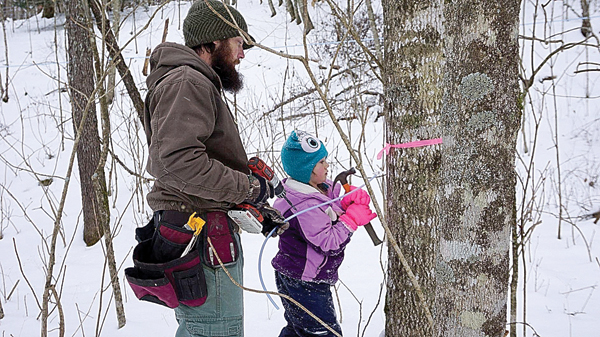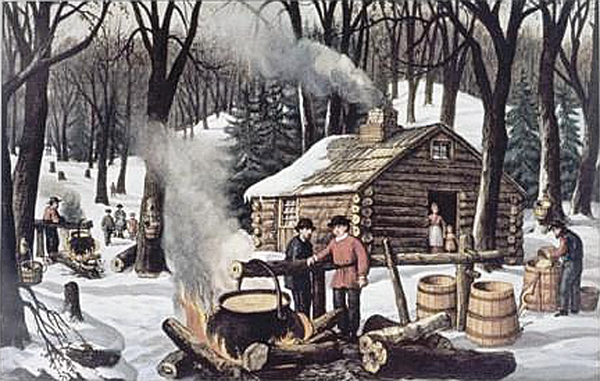

Tapping the sugarbush
From sap to syrup
Part One
I cannot imagine tucking into a tall stack of pancakes without a liberal dousing of maple syrup. And by maple syrup, I mean real maple syrup, not the amber liquid composed primarily of high-fructose corn syrup and flavored with chemicals or fenugreek. I am speaking strictly of the nectar of maple trees.
Suppose you enjoy real maple syrup, and you live in Pocahontas County. In that case, you are fortunate to have close at hand the two essentials of the sweet bounty of the maple tree. Lots of sugar, red and black maple trees, and the people skilled in extracting the sap from those trees and turning it into a waffle topping rivaling ambrosia.
Not to mention maple candy, butter, cream and even maple cotton candy.
In this episode of the Watoga Trail Report, we will examine the history of “sugar making,” as maple syrup producers call it. Next week, we will narrow our focus down to one young entrepreneurial family in Hillsboro – the Swans. They are joining a growing list of maple product producers in Pocahontas County.
At first glance the whole process looks pretty straightforward, but I assure you it is not. The maple trees produce the sap but obtaining that sap and turning it into maple syrup is time-consuming and physically demanding. And not without logistical problems unique to an industry situated in our mountainous terrain.
Expect a lot of mucking about in the snow if you intend on being a producer. The romantic Currier and Ives portrayal of the steaming sugar shack is after you have collected and transported the sap back to the evaporator. Keep in mind that it takes some 40 to 50 gallons of sap to make one gallon of syrup.
If sugaring is not to be approached as an easy task today, imagine how difficult it must have been before modern labor-saving devices.
It is widely acknowledged and appreciated that Native Americans instructed the early Europeans in the method of making tree syrups.
Archaeologists cannot determine precisely when native peoples started to reduce tree sap to something akin to today’s maple syrup. It is likely that the finished product was not nearly as dense as ours is today.
There are many stories about how the native people discovered the method of making maple syrup. One legend has it that the first use of maple syrup was boiling venison for a great chief’s culinary pleasure.
Today’s maple syrup contains approximately 66% sucrose and has a higher viscosity. So that old legend suggests that the earliest versions of syrup may have been sap boiled just long enough to create a sweet liquid. Many of the legends recount boiling various wild meats in maple sap.
We know that Native people of New England and Canada collected the sap in birch baskets. Dropping hot rocks into the sap turned the liquid to steam, thereby concentrating the sugar in the remaining sap.
One method allowed the baskets of sap to freeze. By removing the ice each day, the remaining liquid became progressively more saturated with sugar over time.
I happen to like that particular method due to a lifelong aversion to physical labor.
When we think of maple syrup, we tend to identify it solely with Canada and the U.S. Almost all of the world’s maple syrup comes from North America, some 85% produced by Canada alone.
Although, Europe did not ignore the sweet treat provided by the sucrose-laden vascular system of birch and maple trees. European and Scandinavian historical records reveal that several tree species were used to make sweet drinks and alcoholic beverages.
Yet, there is little mention of what we in North America would regard as “syrup.” Even today, most maple products sold in Europe are imported from North America.
Modern production systems started with tapping individual trees and catching the sap in buckets. The sugarhouse (also called the sugar shack) was often located close to a dense stand of maple trees, called a sugarbush.
Before the advent of motor vehicles, horse-drawn wagons and sleds transported the sap to the sugar shacks. Sugar shacks were so-called because they were generally simple three-sided wood plank buildings with a roof and dirt floor.
Often depicted in old lithographs, the sugar shack served as a winter gathering place for young and old alike to watch the “boiling off” process. And occasionally enjoying a special treat of snow saturated with maple syrup. The first snow cone, perhaps?
Large sheet-metal pans began replacing iron kettles about the time of the Civil War. These “evaporators” greatly increased the evaporation surface, significantly reducing the boiling time.
The actual boiling temperature for sap is approximately seven degrees above the boiling temperature for water, adjusted for elevation.
Everett Soule invented the first plastic bags for collecting sap in 1950. The 15-quart bags offered the luxury of visibility from a distance rather than walking to the metal bucket to check the volume of sap. Such trips added up when you are tapping hundreds of trees.
As well, there was a growing health concern about lead contamination of syrup from corroded galvanized buckets. Such contamination could also taint the flavor of the finished product with a metallic “off-flavor.”
Off-flavors are also a concern when tapping trees later in the season when the trees start to form buds. Amino acids produced by the trees at this time are suspected of tainting the flavor of the sap.
In the 1970s, plastic tubing revolutionized the sap-collecting process. No more lugging sap-filled containers; a network of tubing carries the sap to a central collection container.
Since using tubing is normally by gravity feed, care must be exercised to strategically set up the network in order to minimize the linear feet of tubing used and maximize the number of taps within the system.
Technology has made the production process much more efficient than in earlier years.
Methods of reducing evaporation time to achieve the desired 66% sugar content of maple syrup include new configurations of evaporators, vacuum pumps, reverse osmosis, and the use of preheaters.
By 1900, some evaporator pans were redesigned with concave “flues” rather than a flat bottom. This creates more surface area exposed to boiling and greatly decreases the boil time.
More recently, the continuous-flow pan with baffles is used by many syrup producers instead of the conventional “single batch” pan. The pan’s design allows for a flow of the sap through the chambers as the sugar density increases, creating a gradient-based gate-keeper between the baffles.
Some producers use vacuum pumps to draw the sap from the trees. The upside is an increase in sap volume, allegedly up to 300%. But critics claim it can damage trees.
An article in Northern Woodlands suggests that vacuum tubing over time can suck wood cell matter into the tube and pull water from the tree, diluting the sap.
Using membrane filters, reverse osmosis is a process that separates water from the sap. This system can increase the sugar content of the liquid by up 25% before the boiling process. That’s a big head start and an obvious time and money saver.
A sap preheater speeds up the evaporation process by warming the sap to near boiling temperature before it enters the evaporation pan. When unheated sap is introduced to the batch, it lowers its overall temperature. Energy is required to bring the batch temperature back up to standard, so preheating saves money and ensures a quality product.
Yet, despite the many technological changes in sugar making, the essential steps haven’t changed at all. Someone must go out in the sugarbush and tap the trees to obtain the sap. The sap must be heated until evaporation has brought the sugar content up to 66%.
Humans find the taste of maple syrup so delicious that they have been following this procedure annually for hundreds, if not thousands of years.
There you go, the story of how maple syrup gets from the tree to your table. And quite possibly more than you ever wanted to know about a pancake topping.
But, when facing down a Belgian waffle on your Sunday morning breakfast plate, there is only one thing in this world that you want to fill those little square reservoirs – Maple Syrup.
From Pocahontas County, of course!
Ken Springer
Ken1949bongo@gmail.com
Citations are available at my email address.


